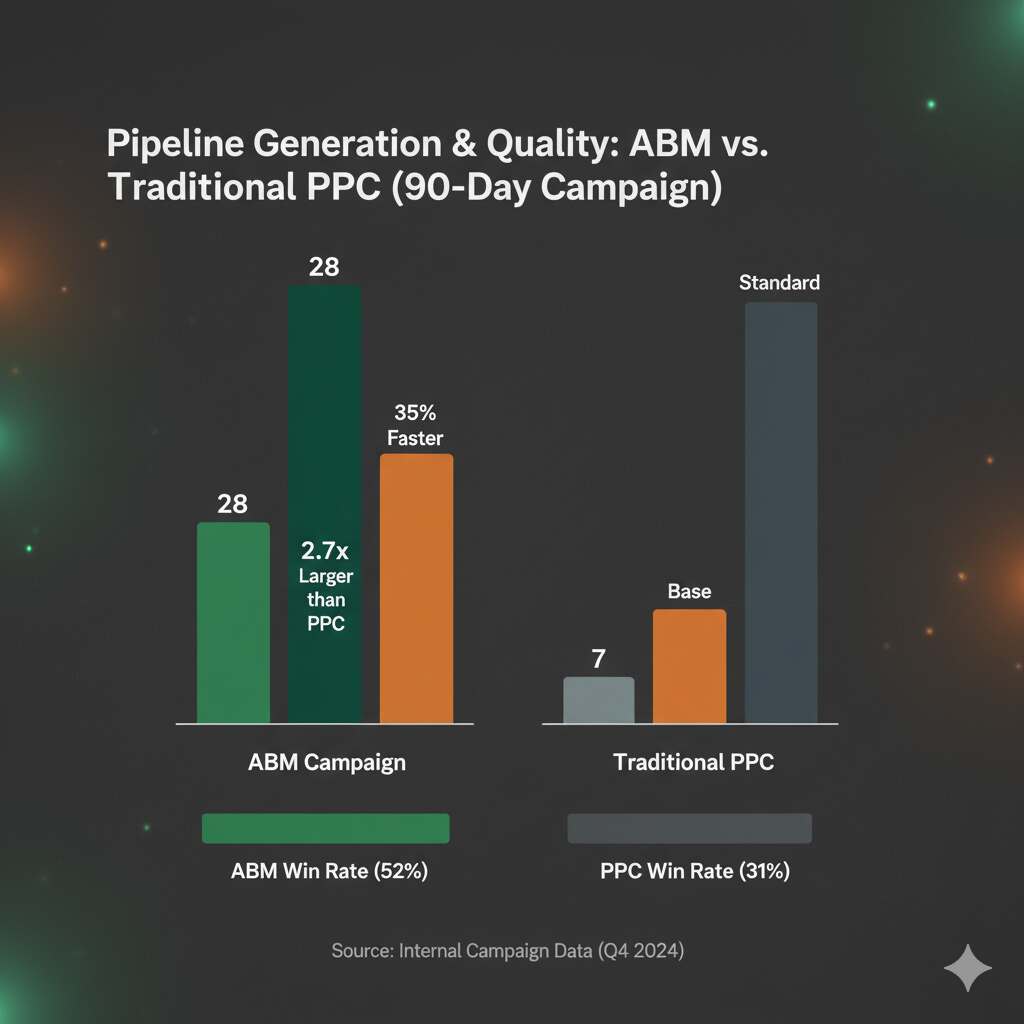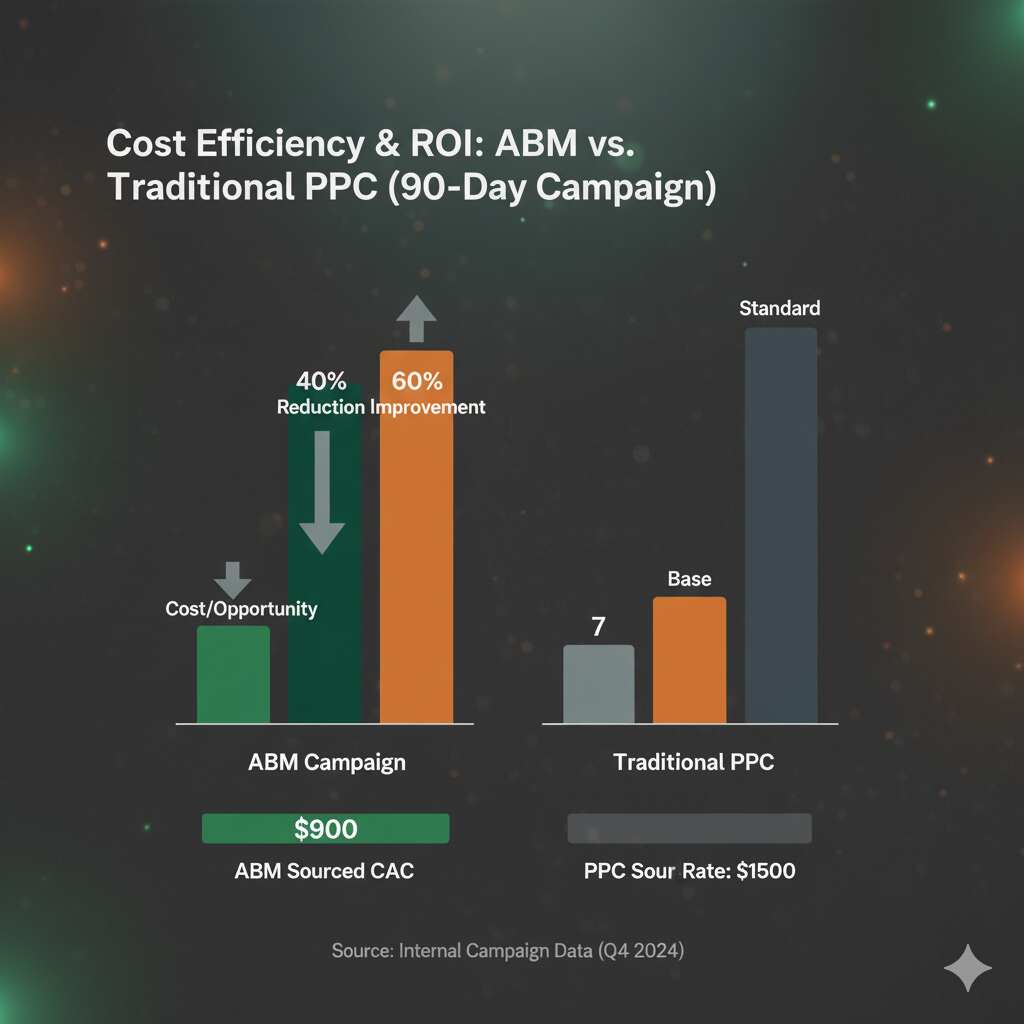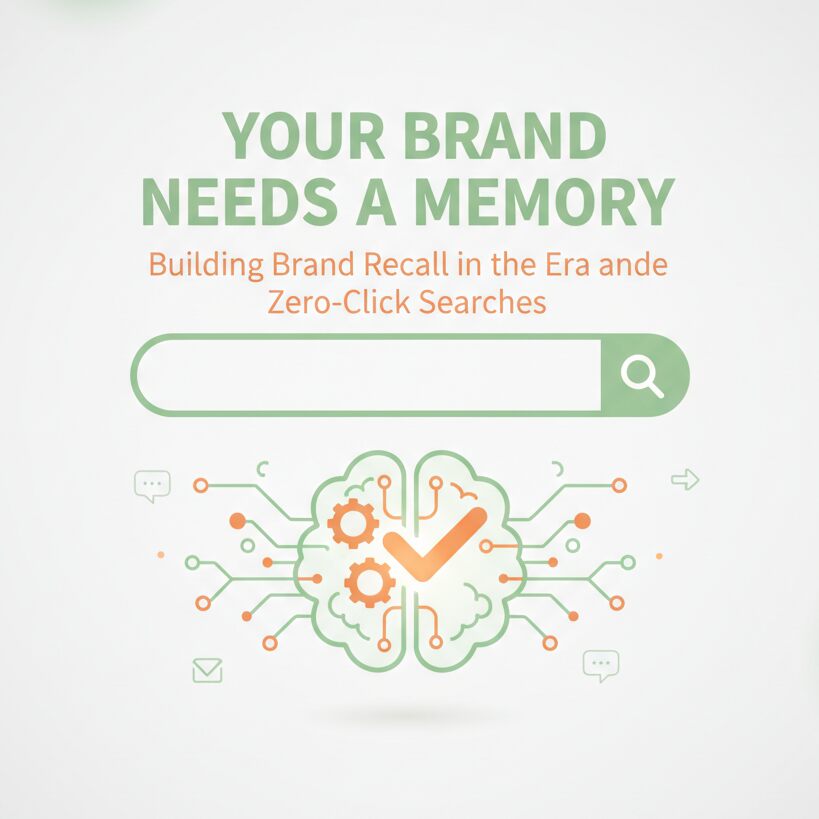The logistics and transportation industry is experiencing a fundamental shift in how companies acquire and retain enterprise customers. Traditional lead generation tactics—casting wide nets through paid search and generic content marketing—are delivering diminishing returns. Decision-makers in supply chain management and procurement are inundated with sales pitches, making it increasingly difficult for trucking companies to stand out.
This is where account-based marketing (ABM) emerges as a game-changing strategy. Rather than pursuing volume-driven lead generation, ABM focuses on identifying, engaging, and converting specific high-value accounts through personalized, multi-channel campaigns.
In this detailed case study, we’ll explore how Lean Summits implemented a comprehensive ABM strategy for a mid-sized trucking and logistics company, resulting in measurable improvements in pipeline quality, engagement rates, and cost efficiency. If you’re a logistics provider struggling to connect with enterprise decision-makers, this blueprint offers actionable insights you can apply to your own business development strategy.
The Client: A Mid-Sized Trucking Company at a Growth Crossroads
Our client was a regional trucking and logistics company operating across the United States, specializing in the movement of interstate and regional freight. With a solid operational foundation and reliable service delivery, the company had built a respectable customer base primarily consisting of small to medium-sized businesses in manufacturing, retail, and wholesale distribution.
However, like many growing logistics providers, they faced several critical challenges:
Limited Enterprise Penetration: Despite having the capacity and infrastructure to serve larger clients, the company struggled to get meetings with decision-makers at enterprise accounts. Their brand recognition beyond existing customer circles was minimal.
Lead Quality Issues: Their existing marketing efforts—primarily Google Ads and basic content marketing—generated leads, but conversion rates were disappointing. Many inquiries came from price shoppers or small accounts that didn’t match their ideal customer profile.
Long Sales Cycles: Without targeted engagement strategies, sales conversations often stall. Decision-makers weren’t receiving the right information at the right time, leading to prolonged evaluation periods.
Competitive Disadvantage: Larger logistics companies with established brands dominated the conversation with enterprise accounts, making it difficult for our client to even get on the shortlist.
The company’s leadership recognized that scaling revenue required a fundamental shift in their go-to-market approach. They needed a strategy that would position them as a preferred partner for high-value accounts—companies that valued reliability, compliance, and strategic partnerships over simply finding the lowest bid.
Setting Clear ABM Objectives: Quality Over Quantity
Before diving into tactics, Lean Summits worked with the client to establish specific, measurable objectives that would guide the entire ABM initiative:
Primary Objective: Generate qualified sales conversations with decision-makers at 120 target accounts within 90 days.
Secondary Objectives:
- Build measurable brand awareness among supply chain and logistics executives in target industries
- Reduce customer acquisition costs compared to existing PPC campaigns
- Increase pipeline quality by focusing on accounts with higher lifetime value potential
- Establish thought leadership in specific verticals (furniture, FMCG, manufacturing, automotive)
The emphasis was explicitly on driving qualified conversations—not just website traffic, form fills, or vanity metrics. Every tactic would be evaluated based on its ability to move decision-makers through meaningful engagement stages toward sales discussions.
Building the Foundation: Ideal Customer Profile and Target Account Selection
The success of any ABM strategy hinges on precise targeting. Lean Summits began by conducting extensive research and analysis to define the client’s Ideal Customer Profile (ICP).
Defining the ICP
Through collaborative workshops with the client’s sales and operations teams, we identified the characteristics of accounts that would benefit most from the client’s services and had the highest potential for long-term value:
Freight Volume Characteristics:
- Medium to large shippers moving 10+ truckloads per month
- Consistent shipping patterns with predictable volume
- Multi-location operations requiring coordinated logistics
Industry Verticals:
- Furniture manufacturers and distributors (bulky, specialized handling)
- Fast-Moving Consumer Goods (FMCG) companies (time-sensitive, volume-based)
- Manufacturing operations (raw materials and finished goods)
- Automotive parts suppliers (precision timing, quality requirements)
Geographic Focus:
- Primary operations in the Midwest and Southeast United States
- Interstate shipping needs along major freight corridors
- Distribution centers in strategic logistics hubs
Decision-Maker Profiles:
- Chief Executive Officers (ultimate decision authority)
- Chief Marketing Officers (brand and customer experience focus)
- Logistics Directors (operational evaluation)
- Supply Chain Managers (day-to-day coordination)
- Procurement Officers (vendor selection and contracting)
Target Account List Development
With the ICP clearly defined, Lean Summits leveraged multiple data sources to build a comprehensive target account list:
Research Tools Utilized:
- LinkedIn Sales Navigator for decision-maker identification and company intelligence
- ZoomInfo for contact data enrichment and firmographic information
- Apollo.io for additional contact verification and company insights
- Industry databases and trade association directories for sector-specific intelligence
The final target list consisted of 120 carefully selected accounts that met the ICP criteria. Each account was scored based on fit, intent signals, and accessibility of key decision-makers.
Importantly, this wasn’t simply a list of company names. For each target account, we developed detailed profiles including:
- Organizational structure and decision-making hierarchy
- Current logistics providers (where identifiable)
- Recent business developments, expansions, or challenges
- Technology stack and digital maturity
- Competitive positioning and market presence
Crafting Personalized Messaging: Speaking Directly to Pain Points
Generic marketing messages fail in ABM because they don’t acknowledge the specific context and challenges of individual decision-makers. Lean Summits developed persona-specific messaging frameworks that addressed the unique priorities of each stakeholder type.
Messaging by Persona
For Logistics Directors: These operational leaders care about reliability, efficiency, and risk mitigation. Our messaging emphasized:
- Cost optimization through route efficiency and load consolidation—potential savings of up to 15% on transportation spend
- Fleet reliability metrics and on-time delivery performance guarantees
- Technology integration capabilities (TMS compatibility, real-time tracking)
- Capacity assurance during peak seasons
For Chief Executive Officers: C-suite executives focus on strategic partnerships, risk management, and business outcomes. Messaging for this persona highlighted:
- Service-level guarantees that protect brand reputation
- Compliance excellence and insurance adequacy
- Scalability to support business growth initiatives
- Strategic partnership approach versus transactional vendor relationships
For Supply Chain Managers: These professionals need practical solutions that make their daily operations smoother:
- Responsive communication and problem resolution
- Flexible scheduling and load optimization
- Damage prevention protocols for specialty freight
- Performance reporting and continuous improvement processes
For Procurement Officers: Purchasing decision-makers evaluate vendors on value, not just price:
- Transparent pricing structures with no hidden fees
- Contract flexibility and reasonable terms
- Financial stability and insurance coverage
- References and case studies from similar companies
Content Assets Developed
To support these messaging frameworks, Lean Summits created industry-specific content assets:
Industry-Focused Case Studies:
- “How the Firm Reduced Furniture Damage by 60% Through Specialized Handling Protocols”
- “Automotive Parts Supplier Achieves 99.2% On-Time Delivery with Strategic Carrier Partnership”
- “FMCG Distributor Scales Regional Operations Without Logistics Bottlenecks”
Educational Whitepapers:
- “The True Cost of Logistics Failures: Calculating Hidden Expenses in Supply Chain Disruptions”
- “Evaluating Trucking Partners: 12 Questions Every Logistics Director Should Ask”
ROI Calculators and Assessment Tools:
- Interactive cost comparison tools showing potential savings
- Capacity planning worksheets for seasonal demand forecasting
Personalized Landing Pages: Each target account received customized landing page experiences featuring:
- Industry-specific imagery and terminology
- Relevant case studies from their vertical
- Decision-maker testimonials from similar roles
- Clear calls-to-action for consultation requests
Multi-Channel Orchestration: Meeting Decision-Makers Where They Are
ABM succeeds when multiple touchpoints create a cohesive experience across channels. Lean Summits designed an integrated campaign that surrounded decision-makers with relevant, timely messages.
LinkedIn Advertising Campaign
LinkedIn offered unparalleled targeting capabilities for reaching B2B decision-makers:
Targeting Parameters:
- Specific company names from the target account list
- Job titles matching decision-maker personas
- Industry classifications and seniority levels
- Geographic filters for regional relevance
Ad Formats Deployed:
- Sponsored Content showcasing thought leadership and case studies
- Sponsored InMail (Message Ads) with personalized outreach from the CEO
- Dynamic Ads featuring the prospect’s company information
- Video ads demonstrating service capabilities and customer testimonials
Budget Allocation: The LinkedIn campaign received 40% of the total ABM budget, reflecting its effectiveness in reaching senior decision-makers who are less accessible through other channels.
Email Nurture Sequences
Complementing the LinkedIn presence, Lean Summits developed sophisticated email sequences:
Sequence Structure:
- Initial value-driven introduction (no immediate sales pitch)
- Industry insight or trend analysis (positioning expertise)
- Specific pain point addressed with case study (demonstrating relevance)
- Soft call-to-action for consultation or assessment (lowering commitment threshold)
- Follow-up with additional resources (maintaining engagement)
Personalization Elements:
- Account-specific references to recent company news or developments
- Industry challenges relevant to their vertical
- Competitor intelligence (where appropriate and ethical)
- Custom subject lines reflecting their business context
Deliverability Optimization: All emails were sent through authenticated domains with proper SPF, DKIM, and DMARC configurations to ensure inbox placement. Lists were segmented to prevent over-emailing and maintain sender reputation.
Retargeting and Display Advertising
To maintain visibility with engaged prospects, we implemented strategic retargeting:
LinkedIn Retargeting:
- Pixel-based tracking of landing page visitors
- Custom audiences based on video views and content engagement
- Sequential messaging that advanced the conversation
Display Network Retargeting:
- Google Display Network campaigns targeting account IP ranges
- Industry publication placements where decision-makers consume content
- Creative messaging that reinforced the LinkedIn and email narrative
Direct Sales Engagement
Technology and automation only go so far—human connection remains crucial in B2B sales. The ABM strategy included coordinated sales outreach:
LinkedIn Connection Strategy: Sales representatives sent personalized connection requests to decision-makers, referencing:
- Shared industry challenges
- Mutual connections or associations
- Relevant content the prospect had engaged with
- Specific value propositions for their company
Follow-Up Calling: After digital engagement signals (landing page visits, email opens, LinkedIn profile views), sales reps initiated phone outreach with context:
- “I noticed you downloaded our guide on furniture logistics optimization…”
- “I saw you’re connected with [mutual contact] and thought we should connect…”
- “Given your company’s recent expansion announcement, I wanted to discuss how we’ve helped similar companies scale their logistics…”
This coordinated approach ensured that outreach felt helpful and contextual rather than intrusive and generic.
Tracking Engagement: Measuring What Matters
ABM requires sophisticated measurement beyond standard marketing metrics. Lean Summits implemented comprehensive tracking to monitor account engagement and campaign effectiveness.
Technology Stack Implementation
HubSpot CRM Integration:
- Account-level engagement scoring
- Contact and company record enrichment
- Email sequence automation and performance tracking
- Deal pipeline management with ABM source attribution
Google Analytics 4 Configuration:
- Company identification through IP resolution
- Custom events tracking ABM-specific conversions
- Enhanced e-commerce tracking for multi-touch attribution
- Audience segmentation by account list membership
Multi-Touch Attribution Modeling: Rather than relying on last-click attribution, we implemented position-based attribution that recognized the contribution of each touchpoint in the buyer journey.
Key Performance Indicators Monitored
Account Coverage Metrics:
- Percentage of target accounts with at least one touchpoint (achieved: 89% within 30 days)
- Average number of decision-makers engaged per account (3.4 contacts per account)
- Percentage of C-suite engagement (37% of target CEOs/CMOs directly engaged)
Engagement Quality Metrics:
- Email open rates by persona (averaged 38% for personalized sequences vs. 22% for generic campaigns)
- LinkedIn ad click-through rates (2.4% CTR vs. industry average of 0.9%)
- Landing page conversion rates (18% for personalized pages vs. 7% for generic pages)
- Content download rates by asset type
Sales Activity Metrics:
- Meeting booking rate from engaged accounts (23% of engaged accounts scheduled consultations)
- Sales conversation quality scores (subjective assessment by sales team)
- Proposal request rate from initial conversations
- Average deal size from ABM-sourced opportunities
Remarkable Results: The 90-Day ABM Impact

After three months of coordinated ABM execution, the results demonstrated the power of focused, personalized marketing:
Account Engagement Success
Coverage Achievement: 89% of the 120 target accounts showed measurable engagement with at least one campaign element—LinkedIn ad clicks, email opens, landing page visits, or direct sales connections. This represented exceptional reach given the specificity of the audience.
Multi-Channel Engagement: 47% of target accounts engaged across multiple channels (e.g., both LinkedIn and email), indicating coordinated brand awareness building and message reinforcement.
Decision-Maker Access: The campaign successfully reached 163 individual decision-makers across the target account list, averaging 1.4 high-level contacts per account—a critical achievement for relationship-based sales.
Pipeline Generation and Quality
Qualified Opportunities Created: The ABM campaign generated 28 active sales opportunities from the target account list—a 23% conversion rate from engaged accounts to qualified pipeline.
Average Deal Size: ABM-sourced opportunities averaged 2.7 times larger than deals from traditional PPC lead generation, reflecting a focus on enterprise accounts with substantial freight volumes.
Sales Cycle Acceleration: Deals originating from ABM-engaged accounts moved through the sales pipeline 35% faster than other opportunities, thanks to the pre-education and relationship building that occurred during marketing engagement.
Win Rate Improvement: Early indicators suggested a significantly higher win rate for ABM-sourced opportunities (52% vs. 31% for traditional leads), though the campaign duration limited the number of closed deals for definitive analysis.
Cost Efficiency and ROI
Customer Acquisition Cost Reduction: By focusing resources on high-probability accounts, the campaign achieved a 40% reduction in cost-per-opportunity compared to broad-based PPC campaigns.
PPC Optimization Impact: Insights from ABM engagement informed PPC keyword and audience refinements, improving overall paid search efficiency by 27%.
Marketing-Sales Alignment: The coordinated approach reduced wasted sales effort on unqualified leads, with sales representatives reporting a 60% improvement in the quality of conversations generated by marketing.
Brand Visibility and Thought Leadership
LinkedIn Presence Growth: The client’s company page gained 340 new followers from target industries, representing a 78% increase in relevant audience reach.
Content Engagement: Industry-specific case studies and whitepapers generated 890 downloads from target accounts, establishing credibility and expertise.
Share of Voice Improvement: Brand mention tracking showed a 45% increase in industry forum and LinkedIn discussion references, indicating growing awareness among the target audience.
The ABM-PPC Integration Advantage
A critical insight from this campaign was the synergistic relationship between ABM and traditional PPC advertising:
PPC Provides Volume and Discovery: The client’s existing Google Ads campaigns continued to generate approximately 60 inquiries per month at an average cost-per-click of $50. While many of these leads weren’t ideal fits, PPC served an important role in capturing in-market demand from companies actively searching for trucking services.
ABM Provides Quality and Relationship Building: ABM complements PPC by proactively engaging target accounts before they enter active buying mode. Rather than waiting for companies to search, ABM positioned the client as a known, trusted option when logistics challenges arose.
Integration Creates Efficiency: By cross-referencing PPC lead sources against the ABM target account list, the sales team could prioritize high-value inbound leads. When someone from a target account filled out a contact form, they received an immediate, personalized follow-up rather than entering a generic nurture sequence.
Remarketing Amplification: Website visitors from PPC campaigns who matched the ICP profile were added to ABM remarketing audiences, ensuring that even non-converting traffic from ideal accounts continued to see relevant messaging across channels.
The result was a cohesive demand generation strategy that balanced volume (PPC) with quality (ABM), resulting in higher overall pipeline velocity and conversion rates.
Key Lessons and Best Practices from This ABM Success

1. Rigorous ICP Development is Non-Negotiable
The campaign’s success began with disciplined target account selection. By investing time upfront to define precisely which accounts would benefit most from the client’s services, every subsequent decision became clearer and more effective.
2. Personalization Must Be Authentic and Relevant
Generic personalization tokens (first name, company name) aren’t enough. Effective ABM messaging demonstrates genuine understanding of the account’s business challenges, industry dynamics, and specific operational context.
3. Multi-Channel Consistency Creates Credibility
When decision-makers encountered coordinated messaging across LinkedIn, email, display ads, and sales outreach, it signaled a sophisticated, professional organization worth considering—not just another vendor sending spam.
4. Sales-Marketing Alignment is the Differentiator
The most successful accounts in this campaign were those where marketing engagement was immediately followed by relevant, personalized sales outreach. Silos between marketing and sales destroy ABM effectiveness.
5. Patience and Persistence Pay Off
Not every account engaged immediately. Some decision-makers took 45-60 days to respond to outreach. Maintaining consistent, valuable touchpoints without being aggressive was crucial for long-term relationship building.
6. Measurement Must Be Account-Centric
Traditional marketing metrics (impressions, clicks, leads) don’t tell the full story in ABM. Account-level engagement tracking and pipeline influence measurement provide more actionable insights.
The Path Forward: Scaling ABM Success
Following the initial 90-day campaign, Lean Summits worked with the client to expand and refine their ABM approach:
Target List Expansion: Based on campaign learnings, the account list was expanded to 200 companies, incorporating newly identified high-potential sectors.
Account-Based Advertising Scaling: LinkedIn campaign budgets were increased by 60%, with additional investment in programmatic display advertising targeting account IP ranges.
Sales Process Refinement: Sales playbooks were updated to reflect insights from ABM conversations, including common objections, competitive positioning, and effective value propositions.
Customer Marketing Integration: Existing satisfied customers in target industries were engaged as advocates, providing testimonials, case study participation, and potential referral introductions.
Predictive Analytics Implementation: Website engagement data and intent signals were integrated to identify accounts showing early buying signals, enabling proactive outreach timing.
Why ABM is Essential for Logistics Companies in 2025
The transportation and logistics industry is increasingly competitive and commoditized. In this environment, traditional marketing approaches that treat all prospects equally cannot deliver the growth that ambitious companies require.
Account-based marketing offers logistics providers a strategic framework for:
Breaking Through Noise: Decision-makers are overwhelmed with generic pitches. Personalized, relevant outreach stands out and commands attention.
Building Strategic Relationships: Logistics partnerships are relationship-based. ABM facilitates the multi-touch engagement necessary to build trust before a need arises.
Demonstrating Expertise: Industry-specific content and messaging position providers as specialists rather than generalists, commanding premium pricing and customer loyalty.
Optimizing Resource Allocation: By focusing sales and marketing resources on high-probability, high-value accounts, companies maximize return on investment and accelerate growth.
Creating Competitive Advantage: Most trucking companies still rely on referrals and basic digital marketing. Sophisticated ABM execution creates differentiation that’s difficult to replicate.
Conclusion: From Volume to Value in B2B Marketing
This case study demonstrates a fundamental truth about modern B2B marketing: quality trumps quantity when targeting enterprise accounts. The trucking and logistics company profiled here transformed its go-to-market approach from reactive, volume-driven lead generation to proactive, relationship-focused account engagement.
The results—89% account coverage, 28 qualified opportunities, 40% reduction in customer acquisition costs, and 23% higher pipeline generation—prove that strategic ABM delivers measurable business impact when executed with rigor and personalization.
For logistics providers struggling to connect with enterprise decision-makers, the message is clear: account-based marketing isn’t just a tactic—it’s a strategic imperative for sustainable growth in an increasingly competitive market.
If your trucking or logistics company is ready to move beyond generic lead generation and build meaningful relationships with high-value accounts, the ABM framework outlined in this case study provides a proven blueprint for success.
About Lean Summits
Lean Summits specializes in strategic account-based marketing and demand generation for B2B companies in logistics, supply chain, and industrial sectors. Our data-driven approach combines sophisticated targeting, personalized messaging, and multi-channel orchestration to help growing companies connect with enterprise decision-makers and accelerate pipeline growth.
Ready to Transform Your Logistics Marketing Strategy?
Contact Lean Summits today to discuss how account-based marketing can help your company engage high-value accounts, reduce customer acquisition costs, and build a sustainable competitive advantage.



